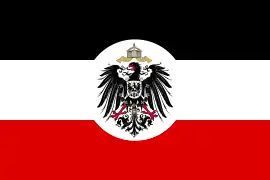.svg.png.webp) | |
| Use | State flag, civil and state ensign |
|---|---|
| Proportion | 2:3 (3:5 in 1933–1935) |
| Adopted |
|
| Relinquished |
|
| Design | A horizontal tricolour of black, white, and red |
The Flag of the German Empire, or Imperial Flag, Realm Flag, (German: Reichsflagge) is a combination between the flag of Prussia and the flag of the Hanseatic League. Starting as the national flag of the North German Confederation, it would go on to be commonly used officially and unofficially under the nation-state of the German Reich, which existed from 1871 to 1945.
History
1867-1935
The flag was first proposed and adopted under the leadership of Otto von Bismarck, where it would be used as the flag of the North German Confederation which was formed in 1867.[1] During the Franco-Prussian War, the German Empire was founded (i.e., the South German states joined the Confederation). Germany would continue using it until the German Revolution of 1918–1919, which resulted in the founding of the Weimar Republic.[2]

The Weimar Republic did not use it as a national flag though it did see use within the Reichswehr and by many paramilitary organizations including the Freikorps.[3] It would see usage by right-wing conservative and liberal political parties, including the German National People's Party and the German People's Party. Immediately after the electoral victory of the Nazi Party in March 1933, German President Paul von Hindenburg reinstated the flag by decree as the co-official flag of Germany.[4] In 1935, a year after Hindenburg's death, the Imperial Flag was banned from use as the national flag in favour of the black-red-white swastika flag.[5]
East and West
During World War II, German exiles in the Soviet Union called the National Committee for a Free Germany adopted it as their new flag for a free German state. Many members of this organization would play a role in the Soviet occupation and organization of the East German government. Due to this, after World War II, by those who saw the Imperial flag as a symbol of German resistance to Nazism and by those that saw the black-red-gold flag as a symbol of the failed Weimar republic. it was proposed that East Germany adopted the Imperial Flag as their national flag. [6][7]
After German Reunification
Due to the ban on Nazi swastika flag in modern Germany, many German Neo-Nazis instead adopted the Imperial Flag. However, the flag never originally had any racist or anti-Semitic meaning, despite its brief use in Nazi Germany.[8]
The flag is almost graphically identical to the modern flag of the Republic of Yemen, albeit with the colours reversed upside down and a different shade of red. The flag of Upper Volta, used in 1958–1984, had the same colour arrangement but with a slightly different shade of red.
Gallery
.svg.png.webp) War Ensign of Germany (1867–1892)
War Ensign of Germany (1867–1892).svg.png.webp) War Ensign of Germany (1903–1919)
War Ensign of Germany (1903–1919)_Iron_Cross_variant.svg.png.webp) War Ensign of Germany (1903–1919) - Variant
War Ensign of Germany (1903–1919) - Variant Flag of the Imperial Colonial Office (1907–1919)
Flag of the Imperial Colonial Office (1907–1919).svg.png.webp) War Ensign of Germany (1921–1933)
War Ensign of Germany (1921–1933).svg.png.webp) Service flag of the Reich authorities at sea (1921–1926)
Service flag of the Reich authorities at sea (1921–1926).svg.png.webp) Flag of Germany (1933–1935)
Flag of Germany (1933–1935).svg.png.webp) Flag of the North German Confederation and German Empire (1867–1918)
Flag of the North German Confederation and German Empire (1867–1918) Service Flag of the Reich (1933–1935)
Service Flag of the Reich (1933–1935).svg.png.webp) Jack of North German Confederation and German Empire (1866–1903)
Jack of North German Confederation and German Empire (1866–1903).svg.png.webp) Jack of North German Confederation and German Empire (1866–1903) - 3:5 Variant
Jack of North German Confederation and German Empire (1866–1903) - 3:5 Variant
Groups that use the Imperial flag
Historical
Modern day
See also
References
- ↑ "North German Confederation* - Countries - Office of the Historian". history.state.gov. Retrieved 2021-04-10.
- ↑ "Weimar Republic". HISTORY. Retrieved 2021-04-10.
- ↑ Zama, Sarah (2021-05-16). "Reichswehr". Never Was. Retrieved 2021-08-25.
- ↑ "ÖNB-ALEX - Deutsches Reichsgesetzblatt Teil I 1867-1945". Österreichische Nationalbibliothek. Retrieved 14 November 2021.
- ↑ "ÖNB-ALEX - Deutsches Reichsgesetzblatt Teil I 1867-1945". Österreichische Nationalbibliothek.
- ↑ "Finding the last emblems of the German Democratic Republic in Berlin". 2017-09-06. Retrieved 2023-12-18.
- ↑ Lowenfeld, Andreas F. (1952). "The Free Germany Committee. An Historical Study". The Review of Politics. 14 (3): 346–366. doi:10.1017/S0034670500003478. ISSN 0034-6705. JSTOR 1404896. S2CID 146241771.
- ↑ "Imperial German Flag".